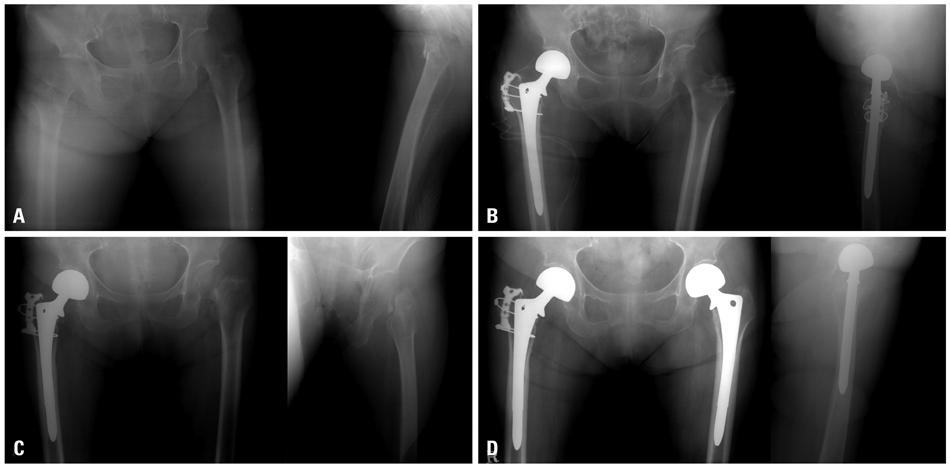Yonsei Med J.
2012 Sep;53(5):1005-1009.
Subsequent Hip Fracture in Osteoporotic Hip Fracture Patients
- Affiliations
-
- 1Department of Orthopedic Surgery, School of Medicine, Inha University, Incheon, Korea. moon@inha.ac.kr
Abstract
- PURPOSE
A significant number of patients who have experienced previous surgical treatment for an osteoporotic hip fracture experience a subsequent hip fracture (SHF) on the opposite side. This study aims to analyze the risk factors and the correlation between osteoporosis and SHF on the opposite side in order to assess the usefulness of bisphosphonate treatment for the prevention of SHFs.
MATERIALS AND METHODS
We included 517 patients treated from March 1997 to April 2009 in this study. The inclusion criteria included previous unilateral hip fracture, without osteoporotic treatment, and a T-score less than -3.0 at the time of the fracture. We studied these patients in terms of death, SHF, alcoholism, living alone, dementia, dizziness, health status, osteoporotic treatment after fracture and bone mineral density (BMD). In total, 34 patients experienced a SHF. We selected another 34 patients without a SHF who had similar age, sex, body mass index, BMD, diagnosis, treatment and a follow up period for a matched pair study. We compared these two groups. The average follow up was 8.3 years and 8.1 years, respectively.
RESULTS
The mortality rate of the 517 patients was 138 (27%). The BMD at the time of fracture demonstrated no statistical difference between the two groups (p>0.05). Nine patients (26%) within the SHF group were prescribed Risedronate and 18 patients (53%) received the same treatment in the non-SHF group. There was a statistical relationship with the treatment of osteoporosis (p=0.026). The average BMD of patients with SHF was -5.13 and -5.02 in patients without SHF was (p>0.05).
CONCLUSION
Although primary surgical treatments are important for an excellent outcome in osteoporotic hip fractures, treatment of osteoporosis itself is just as important for preventing SHFs.
MeSH Terms
Figure
Reference
-
1. Melton LJ 3rd, Chrischilles EA, Cooper C, Lane AW, Riggs BL. Perspective. How many women have osteoporosis? J Bone Miner Res. 1992. 7:1005–1010.
Article2. Cooper C, Campion G, Melton LJ 3rd. Hip fractures in the elderly: a world-wide projection. Osteoporos Int. 1992. 2:285–289.
Article3. Hodsman AB, Leslie WD, Tsang JF, Gamble GD. 10-year probability of recurrent fractures following wrist and other osteoporotic fractures in a large clinical cohort: an analysis from the Manitoba Bone Density Program. Arch Intern Med. 2008. 168:2261–2267.
Article4. Lee SR, Kim SR, Chung KH, Ko DO, Cho SH, Ha YC, et al. Mortality and activity after hip fracture: a prospective study. J Korean Orthop Assoc. 2005. 40:423–427.
Article5. Gardner MJ, Brophy RH, Demetrakopoulos D, Koob J, Hong R, Rana A, et al. Interventions to improve osteoporosis treatment following hip fracture. A prospective, randomized trial. J Bone Joint Surg Am. 2005. 87:3–7.6. Juby AG, De Geus-Wenceslau CM. Evaluation of osteoporosis treatment in seniors after hip fracture. Osteoporos Int. 2002. 13:205–210.
Article7. Cummings SR, Kelsey JL, Nevitt MC, O'Dowd KJ. Epidemiology of osteoporosis and osteoporotic fractures. Epidemiol Rev. 1985. 7:178–208.
Article8. Eastwood EA, Magaziner J, Wang J, Silberzweig SB, Hannan EL, Strauss E, et al. Patients with hip fracture: subgroups and their outcomes. J Am Geriatr Soc. 2002. 50:1240–1249.
Article9. Melton LJ, Riggs BL Jr. Kleerekoper M, Krane SM, editors. Further characterization of the heterogeneity of the osteoporotic syndromes. Proceedings of the International Symposium on Clinical Disorders of Bone and Mineral Metabolism. 1989. New York: Mary Ann Liebert, Inc.;145–152.10. Boston DA. Bilateral fractures of the femoral neck. Injury. 1982. 14:207–210.
Article11. Bell GH, Dunbar O, Beck JS, Gibb A. Variations in strength of vertebrae with age and their relation to osteoporosis. Calcif Tissue Res. 1967. 1:75–86.
Article12. Carter DR, Hayes WC. Bone compressive strength: the influence of density and strain rate. Science. 1976. 194:1174–1176.
Article13. Ryg J, Rejnmark L, Overgaard S, Brixen K, Vestergaard P. Hip fracture patients at risk of second hip fracture: a nationwide population-based cohort study of 169,145 cases during 1977-2001. J Bone Miner Res. 2009. 24:1299–1307.
Article14. Cook PJ, Exton-Smith AN, Brocklehurst JC, Lempert-Barber SM. Fractured femurs, falls and bone disorders. J R Coll Physicians Lond. 1982. 16:45–49.15. Jung ES, Lee YK, Baek SI. Diffrences of bone mineral density between osteoporotic group with or without compression fracture of the spine. J Korean Soc Fract. 1998. 11:629–633.
Article16. Jang J, Kim WL, Kang SB, Lee JH, Yoon KS. The relationship of osteoporosis and hip fractures in elderly patients. J Korean Hip Soc. 2008. 20:299–304.
Article17. Assessment of fracture risk and its application to screening for postmenopausal osteoporosis. Report of a WHO Study Group. World Health Organ Tech Rep Ser. 1994. 843:1–129.18. McClung MR, Geusens P, Miller PD, Zippel H, Bensen WG, Roux C, et al. Hip Intervention Program Study Group. Effect of risedronate on the risk of hip fracture in elderly women. N Engl J Med. 2001. 344:333–340.
Article19. Bilezikian JP. Efficacy of bisphosphonates in reducing fracture risk in postmenopausal osteoporosis. Am J Med. 2009. 122:2 Suppl. S14–S21.
Article20. Kanis JA, Johnell O, De Laet C, Johansson H, Oden A, Delmas P, et al. A meta-analysis of previous fracture and subsequent fracture risk. Bone. 2004. 35:375–382.
Article
- Full Text Links
- Actions
-
Cited
- CITED
-
- Close
- Share
- Similar articles
-
- Risk Factors for Subsequent Contralateral Hip Fracture following Osteoporotic Hip Fracture Surgery
- Osteoporotic Hip Fracture: How We Make Better Results?
- Intertrochanteric fracture associated with posterior hip dislocation
- Clinical Efficacy of Korean FRAX(R) Model in Patients with Hip Fracture
- Orthopaedic Surgical Treatment of Hip Fractures


